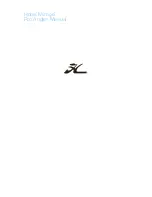
CS36T Owner’s Manual
Page 26
examination done at monthly intervals
Turnbuckles should be checked top and bottom for open cotter pins, which should be turned back and
taped, spreaders should be checked for alignment and that their pins are in. Spreader ends should be
taped and inspected so that no sharp edges are exposed to the Genoa Leech
On standing wire rigging check for ripped or protruding strands and signs of rust or wear in wire where it
enters terminal end fittings.
It is good safety practice, particularly when sailing in saltwater, to paint a small white ring around the
wire base where it enters a terminal. The paint will indicate if any slippage occurred and will also
prevent salt from collecting in the small crevices between the strands, which will in time induce
corrosion
If any signs of rust or wear are found, the rigging should be replaced.
Rod rigging should be examined for kinks and nicks and any signs of fatigue near rod terminal end
fittings should be reported to your dealer.
10.8
Running Rigging
Running rigging defines all the gear that is used in handling and trimming of sails, such as sheets,
halyards, guys and vangs.
Main and genoa halyards are stainless steel wire and are subject to heavy loads and constant flexing as
they pass over sheeves at the head of the mast and turning sheeves or turning blocks at the foot of the
mast.
This constant flexing tends to fatigue the metal over a period of time, and therefore halyards should be
frequently examined for broken strands or signs of stress and should be replaced when such problems
arise. End fittings on halyards and the splice with rope tails are points of weakness and should be
inspected.
Rope halyards are less subject to wear and are primarily used for spinnakers. They need to be checked
only twice in a season. Each end fitting should be checked to ensure they close and lock each time the
boat is sailed. Frayed rope sheets should be replaced when necessary.
10.9
Steering
The detailed manufacturer's maintenance guide and parts list should be closely followed. Roller bearings
in the pedestal were lubricated by the manufacturer. After two seasons, apply lubrication in the holes
provided on top of each bearing. Over-lubrication could affect the brake pads. The roller chain should be
lightly oiled with #30 motor or machine oil every two months. The holes in the sheeve bearing should be
oiled four times a season.
















































